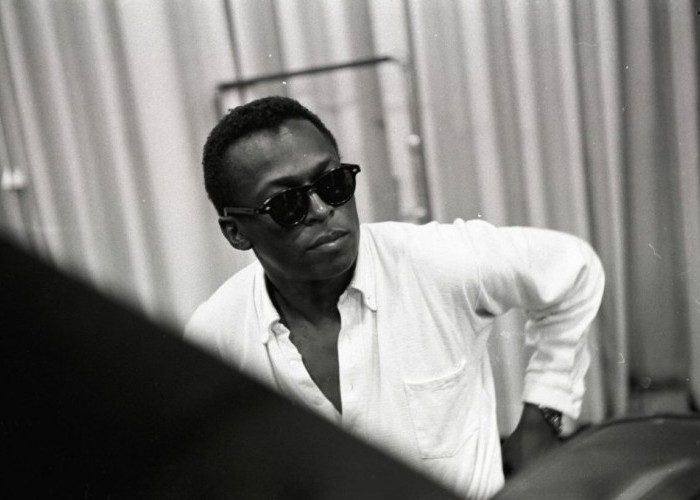Jun 3, 2025 11:25 AM
In Memoriam: Al Foster, 1943–2025
Al Foster, a drummer regarded for his fluency across the bebop, post-bop and funk/fusion lineages of jazz, died May 28…

Miles Davis during the ’Round About Midnight sessions in June 1956
(Photo: Don Hunstein/Sony Music Archives/Courtesy of Abramorama/Eagle Rock)Miles Davis was a difficult man. Even those who are passingly familiar with his biography know that to be true.
He was an on-again, off-again drug addict for much of his life—heroin and cocaine being his primary lures. He had a terrible temper. He was violent. He was extremely paranoid. He was often in pain. If he didn’t like you, you were a “motherfucker”—and if he did like you, then maybe you were a “motherfucker,” too.
Filmmaker Stanley Nelson’s new documentary, Miles Davis: Birth of the Cool, doesn’t shy away from that side of Davis. It’s a part of the trumpeter that’s inseparable from his allure, his understated charisma. How could such a troubled man have produced such beautiful music? That’s always been the question when considering Davis’ work, and Nelson doesn’t necessarily seek to answer it. He does, however, throw the question into relief, poking and prodding it, drawing out Davis’ many contradictions. The film has a spare and quiet vibe; it embodies the loneliness, the sense of alienation, that Davis seemed to have felt all his life.
“Not only is Miles’ music incredible—it spans so many eras, and it’s so influential. But Miles is also just a fascinating character and individual,” Nelson said, a few days before the movie’s Aug. 23 premiere at Manhattan’s Film Forum. Beginning in September, the film opens in select theaters nationwide. Nelson, whose previous documentaries include The Murder of Emmett Till and Jonestown: The Life and Death of Peoples Temple, said that he always had wanted to make a documentary about a jazz musician—“and who’s better than to make a film about than Miles?”
The movie follows, in chronological fashion, the peaks and troughs of the trumpeter’s life, beginning with his relatively privileged upbringing in East St. Louis, Illinois. It’s meant for initiates, but there still are some surprises for those who already are familiar with his work. We learn, for instance, that a young Davis liked to go into the woods and listen to the animals and play what he was hearing—a practice reminiscent of multi-reedist Eric Dolphy, who was known to imitate bird song and whom Davis once called a “sad motherfucker.”
Nelson lingers on Davis’ vast musical oeuvre, but it never feels as if he is checking anything off a list. Perhaps that’s because the movie is, in parts, narrated by an actor whose raspy voice serves as a stand-in for Davis. This gives the film an emotional weight that reinforces the narrative. Nelson also leaves ample room for the music itself, letting at least one song play in its entirety. (Nelson said he listened exclusively to Davis’ music for two years while making the film.) Additionally, there is never-before-seen archival footage that helps to humanize the man whose music shaped the evolution of jazz itself, from the time he first moved to New York in 1944 until his death in 1991 at age 65.

Foster was truly a drummer to the stars, including Miles Davis, Sonny Rollins and Joe Henderson.
Jun 3, 2025 11:25 AM
Al Foster, a drummer regarded for his fluency across the bebop, post-bop and funk/fusion lineages of jazz, died May 28…

“Branford’s playing has steadily improved,” says younger brother Wynton Marsalis. “He’s just gotten more and more serious.”
May 20, 2025 11:58 AM
Branford Marsalis was on the road again. Coffee cup in hand, the saxophonist — sporting a gray hoodie and a look of…

“What did I want more of when I was this age?” Sasha Berliner asks when she’s in her teaching mode.
May 13, 2025 12:39 PM
Part of the jazz vibraphone conversation since her late teens, Sasha Berliner has long come across as a fully formed…

Roscoe Mitchell will receive a Lifetime Achievement award at this year’s Vision Festival.
May 27, 2025 6:21 PM
Arts for Art has announced the full lineup for the 2025 Vision Festival, which will run June 2–7 at Roulette…

Benny Benack III and his quartet took the Midwest Jazz Collective’s route for a test run this spring.
Jun 3, 2025 10:31 AM
The time and labor required to tour is, for many musicians, daunting at best and prohibitive at worst. It’s hardly…